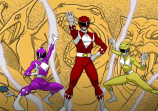There are many consoles that game lovers have owned over the years, but hardly get any mention in today's sophisticated gaming environment. Making a console a success is a tricky combination of selecting the right launch titles, effective marketing and alluring yet competitive pricing. It takes a multitude of efforts to convince a gamer to shell out a considerable amount of money for something that is likely to become obsolete in a few years down the line. Here is a list of some of those early gaming consoles that have vanished from our collective memory.
Nintendo Virtual Boy
When Nintendo announced the Virtual Boy on Nov. 14, 1994, the company promised the console would "totally immerse players into their own private universe." However, its attempt to bring 3D effects to the portable gaming ecosystem turned out to be one of the company's biggest failures. Although the console offered a couple of impressive games, it had two major drawbacks. First its portability was compromised as the eyepiece had to be placed like a tripod exactly at the eye level and the player had to look into it like a face mask. Secondly, many gamers reported teary eyes and headaches after using the system for more than 10-15 minutes.
Apple Bandai Pippin
It was Apple's attempt to break into a gaming market dominated by Sony PlayStation, Nintendo 64 and Sega Saturn. The system, designed by Apple and produced by Bandai, carried a Power Macintosh at its heart. Pippin, though not a full-on computer, played games and CD-ROMs (another popular entertainment option of the time) and could also function as a network computer. However, it's high price ($599) and a very limited selection of games (just 18) turned off the consumers from the Apple product and so, it remains Apple's first and last foray into the world of home gaming consoles.
Panasonic 3DO Interactive Multiplayer
Electronic maker Panasonic introduced the 3DO in the early 90's, eying an opportunity to grab a significant gaming market share; however, the effort did not yield the expected results. The 32-bit machine offered a number of impressive arcade ports but failed to withstand the swelling PlayStation tide of the time. The console's heavy price tag ($700) combined with the lack of an outstanding software contributed to its failure.
Atari Jaguar
The first 64-bit gaming system, the Atari Jaguar proved to be a commercial failure, which in fact prompted Atari to leave the home video game console market until the release of the Atari Flashback in 2004. The '64-bit gaming system' claim was later challenged as the components inside the machine were using 32-bit instruction sets.
Sega Saturn
The Sega Saturn is blamed for Sega's subsequent journey downhill, leading to a gradual dissolution of its console manufacturing. The console had a failed release in North America with no good games to boast of and it became quickly irrelevant in terms of market share after the arrival of Sony PlayStation and the Nintendo 64. However, it should be noted that the console was technically on par with the PlayStation in performance and had offered most of the major releases during the first few years of its activity. Sega bears much of the blame for failing to catch up to the PlayStation. As The Hande notes, "Several major releases remained exclusive to Japan due to the company's overtly selective game releasing, which reflected less on the proverbial "Western tastes" than it did on the company's own extremely poor judgement of their prime audience."








